By posting a picture of my idea of rock garden design.
Bob
Comments
Re: This where I get thrown out of all the rock garden societies
And natural looking, with the different size aggregates...
Re: This where I get thrown out of all the rock garden societies
This looks like the gravel moraines in my area. Perfect habitat for Bird's-Foot Violet, Hoary Puccoon, Fringed Puccoon, Prairie Smoke, Violet Woodsorrel, Small Skullcap, Purple Prairie Clover, White Prairie Clover, Cylindrical Blazing Star, Silky Aster, Sky Blue Aster, Smooth Blue Aster, Hill Prairie ecotype of Shooting Star, Yellow Star Grass, Prairie Phlox, Prairie Onion, Prairie Gentian, Seneca Snakeroot, Side-Oats Grama Grass, Little Bluestem, Prairie Dropseed, Carex umbellata, Carex richardsonii and many other great plants.
James
Re: This where I get thrown out of all the rock garden societies
Well Bob you may well need to fall on your sword on this one. However i would be grateful for your Scree two months ago i moved house it had 4 lawns. I have dug up 2 already and at least one more to go.
Re: This where I get thrown out of all the rock garden societies
The new rock garden is actually filled with plants. I hesitate to name them, for fear of bringing the wrath of Nemesis. The other two thirds of this garden are filled with plants that no one else in the world grows and that no one else will ever have unless they come here to take cuttings (talk about Nemesis ...). Could rock gardening be any better than this?
Bob
Re: This where I get thrown out of all the rock garden societies
I enjoyed this last post of yours Bob, hehe... I know all too well the feeling of not
naming the new treasures. I also have a new rock garden ready for the spring, well, more
of a sand bed/rock garden area and I'll be putting in some teenage plants grown from seed.
That is - if they make it through the winter, and then, maybe I'll tempt fate and name
them and put up a photo...
Re: This where I get thrown out of all the rock garden societies
Bob you are really teasing us, will follow this one with interest.
Regards Will
Re: This where I get thrown out of all the rock garden societies
Looks like an enviable garden for alpines, needless to say... much the same sort of substrate that we see in various places on our local hikes: 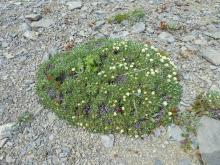
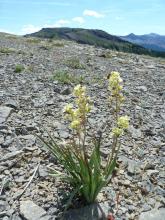
And not so different from this... if you squint a little... ;D 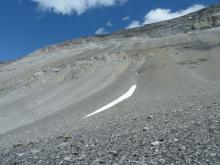
Re: This where I get thrown out of all the rock garden societies
Not exactly the same topic, but two out of three of these are plants that no one else has. Ha!
Three dwarf Picea pungens from Jerry Morris. Top to bottom, "319", "MU 92", and 'Clark's Tiny'. The last was named for the late Clark Coe and is probably in the trade.
(The plants in the new rock garden, the plants that no one else has, are also from Jerry, snatched up right before he decided to give up his dwarf conifer business. I killed a few, naturally, and also wish I'd gotten more plants from him.)
Visitors sometimes ask what I do with the pots in the winter. The answer is, "Nothing". The roots of P. pungens are not damaged at temperatures of -100C when the plants are dormant, and the water needs are next to zero in winter anyway. Insufficient hydration of the plants prior to the onset of dormancy may lead to death, so I do make sure the pots get watered in autumn.
Bob
Re: This where I get thrown out of all the rock garden societies
Here is my idea of a rock garden. If you do not have much, use what you have ...
The former owner dumped gravel on the side of my house to promote drainage. The subsoil is clay and the water level is right at the soil surface in Spring. This makes for a few very muddy months.
I planted this area two years ago. Do you guys recognize the Penstemon species? If you are interested I sent lots of seed into the exchange.
I quickly decided that I needed weed fabric under the rocks. This project took me bits and pieces of time over the course of an entire year. I removed the top 3 to 4 inches of gravel that had sunk into clay. I piled the gravel clay mixture. I used a sieve from my kitchen to wash the clay and sand out of the gravel. I then put the clean gravel back after laying down weed fabric around the plants. This effort has really helped keep the weeds down making this a very low maintenance garden. My work to clean the gravel has prevented the retention of moisture. If the weeds cannot reach moisture ... then no weeds.
I have been picking out the larger gravel and placing it around the edges. This has created a very unnatural, but orderly boarder. I like the way it looks. I originally started doing this where the water drained out the other side of the garden onto my driveway. This dam of larger sized gravel kept the pea gravel from washing onto my driveway. I liked the look so much I decided to border the entire area with larger gravel.
If someone wanted to try something really cool, they could arrange rocks and gravel so the sizes became smaller away from the point of observation. This would give the garden a perspective of great depth. Of course you would also have to plant larger species in the front and smaller species in the back. This would be the opposite of what is typically of gardeners. If done well you could possibly achieve the feeling of depth that is captured in Lori's photo in a very small package.
The only real rock in my garden is a piece of obsidian. I purchased it because it is dark. I thought it would absorb the sunlight and create a place for my butterflies to get warm. After spending $15 I discovered the butterflies preferred to warm themselves on my neighbors dark roof. Oh well, if civilization colapses at least the people of the future will have a source material for arrowheads.
James
Re: This where I get thrown out of all the rock garden societies
I think the idea, promoted by some, that a rock garden has to be built with expensive stone is a huge turn-off for people thinking about starting a rock garden.
I thought about buying stone, then realized who would be the one forced to move the stone from the driveway to an artistic yet naturalistic position in the back yard, then thought about how many more plants I could put in if there weren't huge rocks in the way.
Besides, I had already achieved the desired height with the back issues of National Geographic, broken troughs, tires from cars I no longer owned, etc.
Bob
Re: This where I get thrown out of all the rock garden societies
The similarity between Lori's pictures of alpines in scree and Bob's rock garden design photo is an example of the fact that alpine plants in the wild are rarely found in crevices between parallel stratified rocks. Mountain flowers more commonly occur in scree, moraine and broken rock outcrops. While stratified rock gardens can be very attractive, a chaotic rock garden like Bob's is an alternative that more closely resembles natural plant habitats.
Re: This where I get thrown out of all the rock garden societies
I agree you don't need lots of imported rocks to grow alpines. In the beginning use what you have available, as you become more experienced and have the space and resources then design and build your rock garden, there are plenty of great examples on this and other sites. But a word of warning once bitten by the Rock Gardening bug there is no antidote. Containers are a great way for beginners to start you can use lots of various containers, In Scotland Ian Young has devised an ingenious way to use reclaimed Polystyrene fish boxes. See Ian's article at the following link
Re: This where I get thrown out of all the rock garden societies
I have never bought a stone to use in my garden - all my neighbours carry stones out of their gardens and I carry them to mine! What I lack is a place to build a real rock garden, but I have started the thinking ;D
In nature plants find all kind of places to grow - they need some space to put down roots to get at least some water; minerals they get from the weathering of the rocks.
Here are some examples from different places:
Re: This where I get thrown out of all the rock garden societies
Bob - are all the plants that no one else knows or grows the one's in your book?! (which I hugely enjoyed by the way). I agree totally with the various comments that you don't need loads of expensive rock to grow alpines - all you need is whatever grows them well and what satisfies you. I have had great fun planting in sharp sand. Alan Furness in Northumberland has an extraordinary garden using stone of many different sizes to make a beautifully naturalistic alpine garden. But then Northumberland has a lot of stone! That is the huge delight of growing these plants. The Scots are a canny lot and poystyrene fishboxes are just the ticket, though Joe Elliott at his Broadwell Nursery was very proud of his Saxon coffin!
Trond - do you ever visit the UK? We would love a talk on some of the extraordinary places you visit.
Re: This where I get thrown out of all the rock garden societies
Tim,
thanks for the kind remarks. Is that a Butia I see in the background in the first picture?
The plants in the new rock garden that no one else has are of the same ilk as the piceas 319 and MU 92. One-of-a-kind plants from Jerry Morris. (Which I why I feel like such an idiot killing a few of them. Though rabbits did the initial work.)
My favorite kind of nursery is the kind where there is always an area "in back" with a few plants not grown in sufficient numbers to be put out for sale (we're fortunate in having several of those here).
Jerry's whole nursery was like that. Quite a few of his named dwarf conifers are in the trade, but in the nursery there were plants with just numbers, or, in some cases, no numbers at all.
There was a large wooden trough, falling apart, in back of everything else in the nursery, with several tiny Pinus monophylla in it, and on one visit I made a remark about how much I love that species, and he said the plants were from "broom seed", had not been taken care of for years, and he let me take them home. Among other things.
Then there was the tray of scrub oak seedlings grown from acorns collected by Allan Taylor sitting all by itself in the employees section of Timberline Nursery. Most of those are in the new garden.
At the same nursery, there was this gorgeous peach-watermelon-mango-raspberry colored Echinocereus reichenbachii cross in the display garden, and I asked the owner if there were any plants for sale, and he said there were some in the back greenhouse, but that a well-known horticulturist (not on this list) had been back there the day before.
With a groan I ran back to the back greenhouse, and found four plants left. Should I buy all four? Wasn't that being a hog? What if someone else wanted one? I figured if they did, it would probably die in their garden, so I took all of them.
And they're in the garden, too.
Bob
Re: This where I get thrown out of all the rock garden societies
Some very inspiring photographs, Tim and Trond!
Re: This where I get thrown out of all the rock garden societies
Bob - yes, Butia capitata. I am pleased that it got through last winter. I used to visit the Palm Centre in London many years ago and they sold small seedlings of many species. We also have a form of Chamaerops, which I imagined would be hardier but was damaged by the winter weather.
Re: This where I get thrown out of all the rock garden societies
"My favorite kind of nursery is the kind where there is always an area "in back" with a few plants not grown in sufficient numbers to be put out for sale (we're fortunate in having several of those here)"
Well, Bob, you are fortunate to have several of those indeed! If only.. we had a few around
here. Mind you, I can only imagine how little self control I might have.. I'd probably come home
with all kinds of treasures and forget where my grocery list went in my excitement. But I'd sure
like to opportunity to test myself...
( Thank goodness for seed lists and mail order! )
Re: This where I get thrown out of all the rock garden societies
Some very inspiring photographs, Tim and Trond!
Thanks, Rick ;)
Trond - do you ever visit the UK? We would love a talk on some of the extraordinary places you visit.
It happens, Tim. Had been interesting to take a look in your garden :o
Talking about nurseries with something "in the back". I'm fortunate to know one here. The owner always has a lot of special plants often in small quantity - and I have free access to his greenhouses. I know the guy that propagate the plants as well ;D
Re: This where I get thrown out of all the rock garden societies
Something else in the new rock garden.
Phlox longifolia. I'm probably the only person who would take a picture of a plant with one flower (and a few buds), but I did take this picture less than half an hour ago. P. longifolia has an extravagant display in May and June (and an equally extravagant desire to colonize), and then, for some unknown reason, decides to bloom again as soon as the weather turns cold.
This is actually in an older raised bed but I dug up some of the roots and moved it to the new garden, since it travels so extensively.
I think it was originally from Ratko seed.
Bob
Re: This where I get thrown out of all the rock garden societies
Bob
If you get thrown out of the Societies for not building an outcropping I'll be right behind you.
I've always wondered what the difference is between Phlox longifolia and Phlox stansburyi. I know I've seen them both named in the field but I'll be darned if I can see a difference.
Re: This where I get thrown out of all the rock garden societies
Mark,
No linanthus yet. I did sow quite a bit of calochortus seed, as well as a number of other things.
These are "free range" calochortus, as opposed to the ones in the ranch, down in the lower portion of my estate. Those were also direct sown, but grown in armored "rodent proof" cages (no such thing, but I need to cling to my delusions), which, in my opinion, is the only way to do it.
Bob
Re: This where I get thrown out of all the rock garden societies
Your mentioning growing Calochortus reminded me of your retirement party, Bob, when I was glorying in my Mariposa meadow with some other visitors and you suddenly appeared above me on the West Ridge like a sort of portable Zeus (Cindy Hera like at your side) and proclaimed your congratulations to me on planting such a wad of "Cheap Dutch Bulbs" leaving my hitherto awed audience in stitches. You are the master of the mot!
Re: This where I get thrown out of all the rock garden societies
Well, the main purpose of the new rock garden was to grow a number of Jerry Morris's unnamed and unnumbered conifers, a whole bunch of Allan Taylor's dwarf oaks, and drifts of free-range calochortus. Direct sowing of the last is in my opinion the only way to go.
The bane of the genus as a whole is not "excess moisture" (whatever that is), or "winter wet" (?), or cold, but rabbits.
Very few rabbits find life in the back yard relaxing. Border collies find them an irresistible object for herding. At high speed, of course.
Meanwhile there are a number of species sleeping away, in relative safety, in the calochortus ranch.
Bob
Re: This where I get thrown out of all the rock garden societies
Hi Bob,
I seem to remember that you once suggested (on Alpine-L and subsequently re-printed in our AGS Vic Group newsletter) that to protect susceptible plants from snails and rabbits to plant masses of Calochortus (any species - it doesn't matter) as decoys! ;D
I've resorted to sowing seed of Calochortus in pots but may try your suggestion of "free-range sowing" as well.
cheers
fermi
Re: This where I get thrown out of all the rock garden societies
The main focus in the rock garden is the plants you grow, of course. If you happen to live on rock, that's OK too. The picture is of the latest hunk of ledge being cleared and rehabbed to be ready for spring planting, hopefully. It's been a huge effort to remove poison ivy, saplings and well-established brambles, but worth the effort. Our extended warm autumn has been a help. By now the ground would normally be frozen solid.
Re: This where I get thrown out of all the rock garden societies
I've resorted to sowing seed of Calochortus in pots but may try your suggestion of "free-range sowing" as well.
Yes, well, live and learn. Sigh. The last few winters we've had snow on the ground for months on end, and the rabbits resorted to eating anything and everything. Agaves were eaten to the ground. (In the front yard.) I even saw a rabbit about to bite into a cholla joint, holding it like it was corn on the cob.
For years I sowed calochortus seed in pots. The seed would germinate, I left the pots outdoors for the winter (like I would for anything else), and come next spring, nothing. I attributed this to obvious things like being under a curse, since the seed must germinate in real life and create bulbs that live in the ground, until I talked with a science-oriented horticulturist who explained the difference in volume of soil in a pot vs. in a garden. Calochortus are not cold-hardy in pots.
That's why I now sow the seed direct. In the ranch, a semi-controlled situation, so I can see what germinates, or in the new new rock garden, but always directly into the ground. With a label, if I remember it.
Bob
Re: This where I get thrown out of all the rock garden societies
Bob, I've found the same thing to be true with plants in troughs. If you're in zone 5, for example, many zone 5 plants in troughs will perish over the winter in a normally cold winter. Abnormal appears to be the new normal, but that's another topic. I use plants at least one zone hardier in troughs and have no problems, but I learned this only after killing many plants in troughs.
Re: This where I get thrown out of all the rock garden societies
Anne - I've been helping a friend recently clearing brambles from a new section of garden he wants to make (none of those lovely rocks though!). It certainly is hard work but intensely satisfying. I don't think non-gardeners have any idea of the huge pleasure that comes from giving plants what they want (or at least trying to!). What do you hope to plant in the new outcrop?
I wish we could grow calochortus in the lawn here! Since they are so inexpensive from the Dutch bulb growers maybe it is worth planting a whole lot out just to see the surprise they create. I wonder why they should be so much more difficult than many tulips which are sort of the 'old world' alternatives?
Re: This where I get thrown out of all the rock garden societies
I wonder why they should be so much more difficult than many tulips which are sort of the 'old world' alternatives?
They might not be. As a guess, I would say that the tender types from California "need" a long summer dry period, and the ones from Mexico are winter growers, too.
The hardy ones grow in places with not very much rain.
If you happen to go to Como, Colorado (in South Park, elevation 2991m), and take the Boreas Pass Road out of town (there are maybe ten buildings in Como), on the outskirts is the type locality for Penstemon crandallii, north side of the road. (Also includes "Penstemon teucrioides".) Walk a few paces north of the patch of penstemons and there are Calochortus gunnisonii.
I've never been on skis in 50 years of living here, so see little reason to drive in the mountains during winter, but I figure the growing season there might be a couple of months, with snow lying on the ground the rest of the year. And it does rain in the mountains in the summer.
Cross the dirt road and walk a bit more and there is a large fen filled with Iris missouriensis. (Scene of the one instance where I removed a plant from the wild; the iris was growing in the road and had been flattened by a car.)
Bob
Re: This where I get thrown out of all the rock garden societies
What do you hope to plant in the new outcrop?
Tim, the worst part about the brambles is that the roots were into crevices and rocks. It's been very time-consuming. The rock outcrop faces roughly north to northeast and is a bit protected from the south and west sun. It seems an ideal place for the plants I can't grow in my hot, dry, sun-blistered rock garden. Hellebores, hepaticas, epimediums, jeffersonias for a start because I can divide and plant. I have a list as long as my arm at the moment and as the catalogs arrive it may get longer. It will be a lot of fun because it will be such a departure from the rock gardening I've done to date. It will, however, still be dry, so there will be quite a bit of experimenting - can't wait to start. Also, only half of the outcrop has been cleared - lots of work to do.
Re: This where I get thrown out of all the rock garden societies
I would love to have a rocky outcrop like that! My acreage faces Northwest and is mostly covered by trees and shrubs. I can't just fell my beloved trees and shrubs. 15 years ago I tried to buy a plot of land adjacent to mine but didn't get it. I am still sorry for that (now it is a parking place).

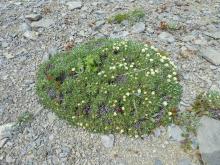
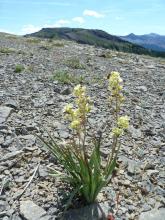
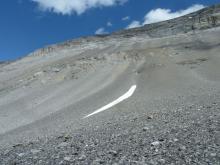
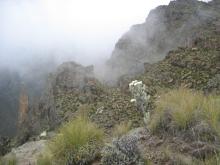
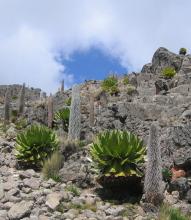
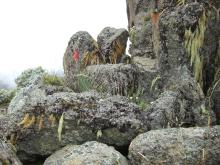
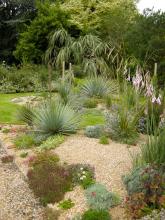
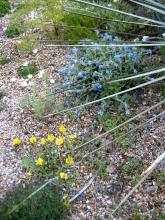
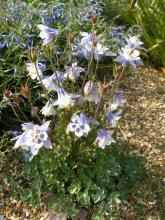
Er! Well! It looks to be a fair scree ;D